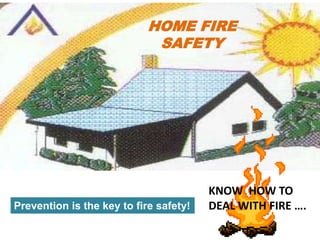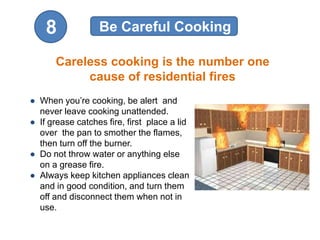Best tips for home fire safety
- 1. HOME FIRE SAFETY KNOW HOW TO Prevention is the key to fire safety! DEAL WITH FIRE ŌĆ”.
- 2. Home Fire Prevention and Preparedness Many fires in the home are caused by a single moment of carelessness and could be easily prevented. It is important to be aware of possible fire hazards around the home and to take steps to protect you and your family from fire. Follow the safety tips listed below to protect yourself and your family.
- 3. 1 House Keeping ŌŚÅ Reduce amount of flammable and combustible materials. ŌŚÅ To reduce ignition hazards. ŌŚÅ To ensure safe emergency evacuation routes. ŌŚÅ Clear walkways/stairways
- 4. 2 Install Smoke Detectors!!! First line of defense ŌŚÅ Smoke detectors give you early warning in case of a fire, so you have precious time to escape safely. Install them on every level of your home, especially outside of sleeping areas. ŌŚÅ Test and vacuum out detectors once a month, and change the batteries when you change your clock in the spring and fall.
- 5. 3 Electrical Fire Safety Faulty electrical equipment or misuse of equipment produces heat and sparks that serve as ignition sources in the presence of flammable and combustible materials. ŌŚÅ Replace or repair loose or frayed cords on all electrical devices or extension cords. ŌŚÅ Do not overload extension cords and run cords along the floor, under rugs and carpets or through doors where they can be damaged.. Each year, electrical shocks and fires cause hundreds of deaths and thousands of injures by following a few basic electrical-safety rules can reduce your riskŌĆ”ŌĆ”
- 6. 4 Storing Flammable and Combustible Liquids ŌŚÅ Flammable liquids must be stored away from ignition sources in cool, well ventilated areas away from incompatible materials. ŌŚÅ Flammable liquids should be stored only in approved safety containers, and the containers should be kept outside the house and garage in a separate storage shed. ŌŚÅ Limit the amount of flammable and combustible liquids to the minimum amount necessary.
- 7. 5 Fire Extinguishers Keep a "ABC-type" fire extinguisher in the kitchen, basement, garage, and workshop for extinguishing all types of fires. Learn how to use the fire extinguisher before you need to use it in an emergency. Remember to only use it on small fires. If there is a large fire, DO NOT attempt to extinguish it, get out immediately and call Fire Rescue Service.
- 8. 6 Family Escape Plan If fire break out in your home ŌĆō get out fast. ŌŚÅ Design an escape plan with your family. Be sure to include two ways out of every room, in case one exit is blocked by flames and smoke. ŌŚÅ Do not block exits with furniture or enclose windows with iron bars that prevent escape. ŌŚÅ Decide on a meeting place for all family members away from the house, where everyone will gather. ŌŚÅ Once outside, never re-enter the house for any reason. ŌŚÅ Practice emergency exit drills at least once every six months, so that each person knows exactly what to do. Never use elevators to escape a fire ŌĆō use stairs
- 9. 7 Candle Safety When there is no electricity supply at home, we normally use candles as an alternative source of lightings. Candles are actually a growing cause of fire. Learn how to be careful with candles. ŌŚÅ Extinguish all candles when leaving the room or going to sleep. ŌŚÅ Keep candles away from items that can catch fire e.g. cloth, books, paper, curtains etc. ŌŚÅ Use candle holders that are sturdy. ŌŚÅ DonŌĆÖt place lit candles in or near windows, where blinds and curtains are installed. ŌŚÅ Keep candles and all open flames away from flammable liquids. ŌŚÅ Keep candles up high out of reach of children and donŌĆÖt allow children or teens to have candles in their bedroom. ŌŚÅ Never leave a child unattended in a room with a candle. ŌŚÅ Try to avoid carrying a lit candle when searching power outages in a confined space. ŌŚÅ Never use a candle for a light when checking pilot lights or fueling equipments as a kerosene heater or lantern.
- 10. 8 Be Careful Cooking Careless cooking is the number one cause of residential fires ŌŚÅ When youŌĆÖre cooking, be alert and never leave cooking unattended. ŌŚÅ If grease catches fire, first place a lid over the pan to smother the flames, then turn off the burner. ŌŚÅ Do not throw water or anything else on a grease fire. ŌŚÅ Always keep kitchen appliances clean and in good condition, and turn them off and disconnect them when not in use.
- 11. 9 Space Heater Safety Portable space heaters can quickly warm up a cold room, but they have also been the cause of many serious home fires. ŌŚÅ Keep portable heaters at least 3 feet away from all combustible materials, including paper, bedding, furniture and curtains. ŌŚÅ Keep small children away from space heaters. ŌŚÅ Make sure you turn the heaters off before leaving your home or going to bed.
- 12. 10 Smokers Need Watchers Carelessly discarded cigarettes are the major cause of fatal home fires - ŌŚÅ Make sure smokers extinguish cigarettes in large, deep ashtrays. ŌŚÅ Fill ashtrays with water before putting in the trash can. ŌŚÅ Check under sofas and chair cushions for cigarette butts after parties.
- 13. 11 If You Catch Fire Stop, Drop and Roll Everyone should know this rule: If your clothes catch fire, don't run! Stop where you are, drop to the ground, cover your face with you hands to protect your face and lungs, and roll over and over to smother the flames.
- 14. 12 If caught in Smoke ! Crawl low under smoke ŌŚÅ Smoke is dangerous! If you encounter smoke, use an alternate escape route. ŌŚÅ If you must exit through smoke, the cleanest air will be 12 to 24 inches (30 to 60 cm) above the floor. ŌŚÅ Crawl on your hands and knees to the nearest safe exit. ŌŚÅ Breath shallowly through nose, and use a filter such as shirt or towel.
- 15. 13 If Trapped in a fire ! If Trapped in a Room ŌŚÅ Seal all doors and vents with duct tape or towels to prevent smoke from entering the room. ŌŚÅ Close as many doors as possible between you and the fire. ŌŚÅ Open a window at the top and bottom so fresh air can enter. Be ready to close the window immediately if it draws smoke into the room. ŌŚÅ Be prepared to signal to someone outside.
- 16. 14 If Trapped in a fire ! If Forced to Advance Through Flames ŌŚÅ Hold your breath. ŌŚÅ Cover your head and hair. ŌŚÅ Keep your head down and your eyes closed as much as possible. ŌŚÅ Move quickly.
- 17. 15 What to do ? In Case of Fire ŌŚÅ Raise Fire Alarm or shout Fire, Fire, Fire ŌĆ”.. ŌŚÅ Telephone Fire Service ŌŚÅ Use appropriate Fire Extinguisher ŌŚÅ Immediately exit the building, using the stairs and closing the doors ŌĆō DO NOT USE ELEVATORS ŌŚÅ Shutoff Utility Valves
- 18. More Presentations: ’üČ Bandaging ’üČ Basic Rescue Knots ’üČ Earthquake Awareness ’üČ Fire Safety ’üČ First Aid ’üČ First Aider ’üČ Hazards & Types of Disasters ’üČ Kids & Emergency ’üČ Kitchen Fire ’üČ Light Search & Rescue ’üČ Water Rescue Techniques ’üČ Wounds & Bleeding For More Topics: http://disaster-risk-management.blogspot.com Thank you for your time 18


















